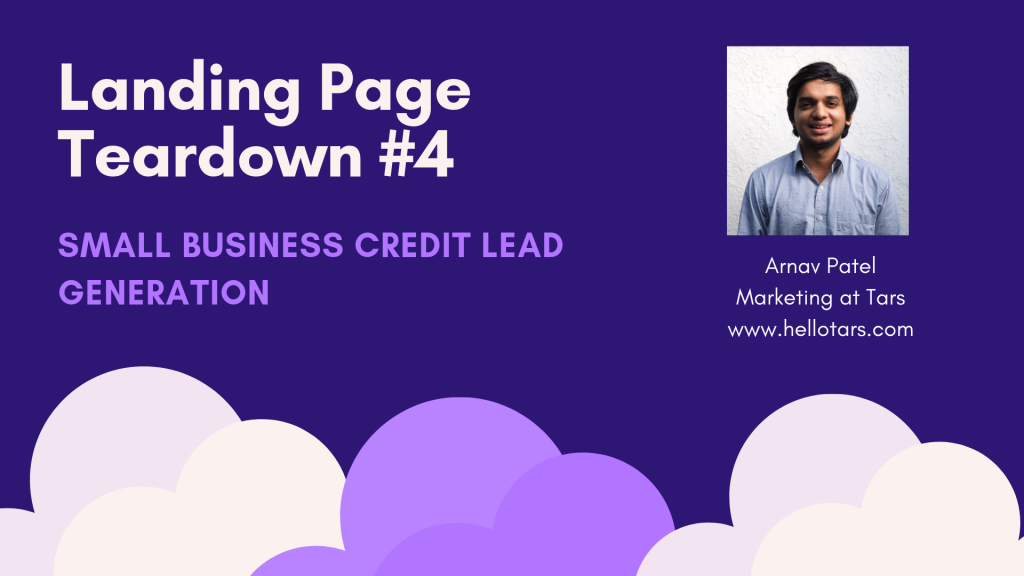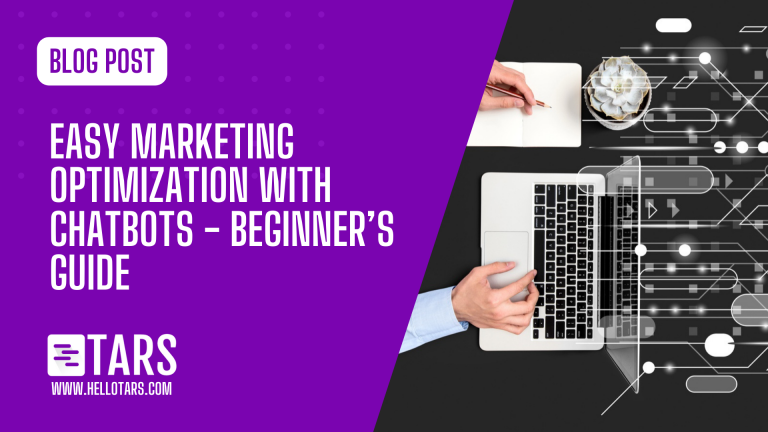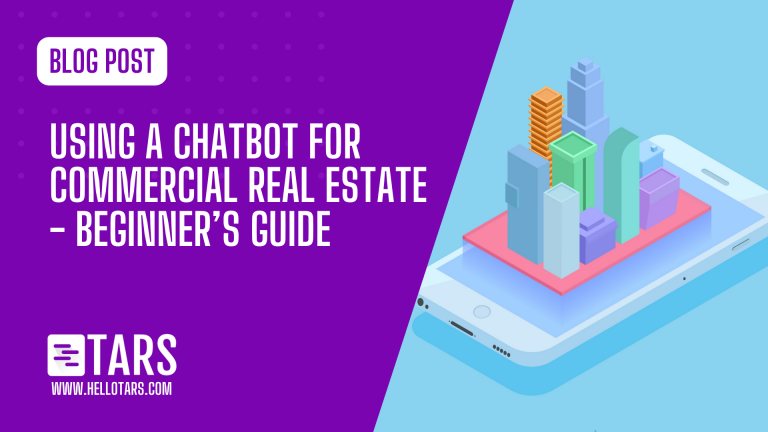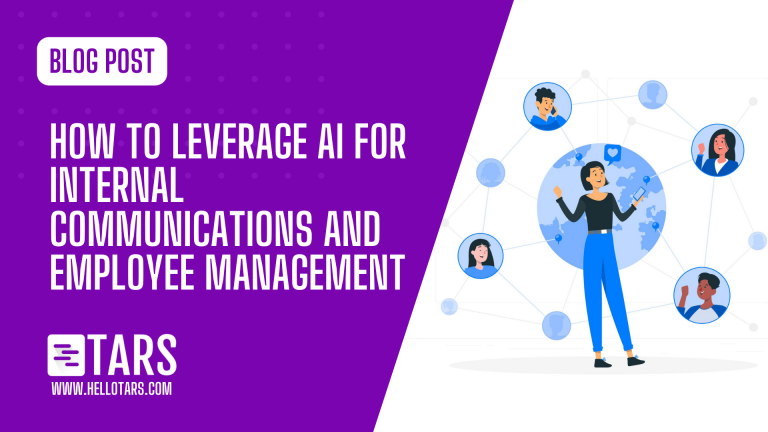[Landing Page Teardown] CRO tips for Small Business Lenders

If you listen to any political or economic discussion on the news, it won’t take long before someone starts talking about job creators, the hallowed group of people that keeps us all employed. But who are they? Is it large multinational corporations? Or is it the thousands of small family-run restaurants, local auto shops or SaaS startups (like Tars) that adorn street faces and co-working spaces across the world? At first glance, it would seem overwhelming like the answer is the former. Companies like Google, Amazon, and Walmart generate billions in revenue every year and employ thousands of workers.
If you delve into the actual data however, you will find that the true job creators (in the United States at least) are in fact small businesses. Over the last 15 years, a staggering ⅔ of all new jobs in America were created by small businesses. They are truly the backbone of America’s massive economy. What makes this possible? In large part, it is the entrepreneurial spirit of the owners who actually do the dirty work of running their businesses. But equally important is the strength of the institutions that make it possible for those owners to start and grow their ventures. One particularly important institution in this regard is credit.
If you’ve ever run a small business of your own, you will know that a key ingredient for the success of small businesses is access to cheap credit. If banks didn’t give out credit, businesses would not buy equipment, rent office spaces, or worse still hire new employees. Put simply, without Small Business credit, the world’s economy would come to a standstill. This week, we took a look at what the digital lead generation experience for small business credit looks like to see how easy lenders make it for America’s job creators to get the capital that they need.
Background Information
What is a small business?
This definition varies by country and industry, but it is important to know this definition because it will decide whether you are eligible for small business credit or not. In the US, the standard is decided by the Small Business Administration who has a handy calculator tool to help you figure out whether you are a small business or not.
As a general rule, they mandate that if you are in manufacturing or mining, you need to have fewer than 500 employees to be considered a small business or if you aren’t in manufacturing or mining you need to have below $7.5 million in annual sales.
How big are small business loans?
Small Business Loans are defined as being less than $1 million dollars in total value. Within this, there are three broad categories which the SBA tracks: less than $100k, $100k-$250k and $250k-$1m.
What do small businesses use credit for?
Small businesses take out credit for a variety of reasons including long-term purchases like equipment purchases as well as more short-term necessities like working capital (or in English, the cost of running a business day to day), or to increase cash flow using accounts receivable financing (i.e. if I run a small business and one of my customers owes me $100 at the end of the month but I need that $100 dollars right now, a bank will give me that money right now as credit and expect me to pay them back with a fee once my customer has paid).
What’s even more interesting in my opinion, is the types of loans businesses take out for different expenses. This is getting a little bit wonky, but an FDIC survey found that businesses take out different types of credit for different types of cost. Specifically, they take out lines of credit for short term costs like working capital while they take term loans for more long term investments like equipment purchases. To oversimplify it, if a farmer needs to buy fertilizer every month, he’s going to get a credit card, but if he needs to buy a tractor he’ll get a loan.
How big is the space?
I couldn’t find any data for 2017 onwards, but in 2016 the total amount of outstanding small business credit amounted to 613.8 billion dollars.
What is their cost per click?
Now we are getting to the important stuff. This is a varied space with a lot of different types of products each with differing levels of demand, but it is quite common for terms to cost over $40. The term “equipment financing” for example has a cost per click of $36.48.
The Landing Page
I looked up “Equipment Loan,” and was unsurprisingly greeted with four ads:
I clicked on the second link and this is the landing page that was served up:
Where do I begin with this page? There are so many issues:
1. Artificial Stock Images
This landing page takes artificial stock images to a whole new level. It makes the LASIK landing page from a few weeks ago look like a web design masterpiece. The whole page is covered in super generic stock images that make the whole page feel really impersonal. It’s almost like someone took a landing page template, changed the text (barely) and just didn’t bother with the images. Other than looking bad, this error diminishes the company’s legitimacy. I know for a fact that if I were actually looking for an equipment loan and I landed on this page, I’d close out of it because the impersonality of the page makes it look unprofessional and spammy. Also, no pics of any actual equipment?!?!
Solution: If they outsource their landing page to an agency, I’d recommend they change their agency because those stock images are downright criminal. If they make these landing pages in-house, outsource the page creation to an agency, because any half decent marketing agency would not be this bad at selecting stock images. If they insist on creating the pages in-house, they should at the very least use a service like Unsplash where the stock images aren’t as “stock.”
2. Lack of messaging focus in the first fold
It’s great that these guys focus on the speed of approval in their “It takes just minutes to get approved!” headline because the application process is the biggest bottleneck in small business lending. But equally, they make literally no mention of equipment financing in the first fold. Combine this with the generic stock image I mentioned above, and the page gets upgraded from spammy and unprofessional to downright shady, and that does nothing but reduce the conversion rate further.
Solution: Since this is a Google Ads landing page, avoiding this issue is easy. Like we do with conversational landing pages at Tars, I’d add a line or two, that relates to the ad copy or the keyword. It doesn’t take much effort, and it makes the page feel more legitimate, professional and generally apt to user intent.
3. Unexplained Jargon
What the hell is a TIB year?
I tried Googling it and I can’t find a satisfactory answer:
For any first-time business owners looking for equipment financing who don’t know what TIB means, this means a guaranteed drop-off. Even if they want to complete the lead generation process, they can’t because they have no idea how to finish the form. American Capital Group is literally just giving away leads at this point.
Solution: If I were them, I’d at the very least add a tooltip, or better yet, I’d dumb down the field, asking for the information in a more easily understandable way. I’d give an example of what this adjusted field label would look like, but I still don’t know what a TIB year is.
4. Too Many Form Fields
The form on this page has 7 fields in it. This is way too much. It requires a considerable amount of time and effort to fill out, and many prospects will not be willing to expend that time or effort when they could easily switch to a competitor’s page with a much shorter, prettier looking form.
Solution: Use a conversational landing page. Honestly, you guys should have seen this coming. Conversational Landing Pages were literally made for this very problem. The back-and-forth nature of a chat conversation means that prospects view only one field at a time and for every field that they do fill they are rewarded with the visual stimulation of a new message bubble popping up. Put simply, the leadgen experience feels more engaging, which allows you to ask for more pieces of information without the prospect dropping. Or in other words, your conversion rate skyrockets.
5. Vague Menu Labels
Some of the menu labels at the top of the page are really vague. For example, “capital equipment” could mean so many different things in this context.
It could mean “capital equipment loans” but then what would that make the current page (which if you remember is the landing page for people looking at equipment financing)? It could be a capital equipment explainer page, explaining the conditions required for equipment to be considered capital equipment. It could also be a page detailing American Capital Group’s capital equipment leasing options! On reading this label At this point, I have three options.
- Ignore the label and continue as if it doesn’t exist (most prospects will probably do this)
- Click the link to find out what it means (some prospects will definitely do this)
- Hit back and click on a competitor’s link.
Prospects in situation A will not be affected by this error and are free to be turned off by the jargon-y form fields, generic stock images, and unfocused messaging on the rest of the page. Prospects in situation B will click on the link to find an essay on the other side, and close the page when they realize this (because who really likes reading about capital equipment), and prospects in Situation C are just lost.
Solution: Add a few more words to the label? It seems obvious to me. Or better yet, just remove the option altogether. It has no bearing on the current lead generation process and could be shown to prospects once they are in the funnel.
6. Call CTA is too small
If you are going to use a traditional landing page, having multiple CTAs is not necessarily a bad thing. For example, having a form and a call-based lead gen option is good because it gives prospects an option in case they like one method better. In this case, especially, the form is so bad that the call CTA isn’t just recommended, it is necessary! Yet, on this page, it is relegated to a tiny little corner, where it languishes with it’s unbolded small font that is easy to miss.
Solution: Even something as simple as making the text a larger font and bold would solve this problem.
7. Basic Grammatical Errors
I seriously didn’t expect to find such an issue on an insurance website, but there are basic grammatical errors on this page. For example, the text in the image below makes no sense:
This, again, harms the company’s legitimacy and increases the likelihood of a prospect dropping.
Solution: Read the page over yourself and once you are done, share it with a few people to find such mistakes.
Conclusion
Unsurprisingly, the biggest bottleneck small businesses face in getting a loan is the application process. As is the case for most financial services, applying for loans is a boring process. It usually requires a lot of really long and boring forms and submitting a whole bunch of really specific documents. In fact, if you make a small mistake in even one form field or submit one wrong document, your whole application could be rejected.
To solve this problem, many credit providers are investing heavily in their digital presence, saving business owners multiple trips to the bank and ostensibly making the form filling process easier. Unfortunately, some lenders have only ended up creating a landing page experience that extends the poor UX of paper of boring paper forms into the digital world.
Arnav is the Director of Content Marketing at Tars. He spends most days building bots, writing about conversational design and scrolling through Giphy’s trending section looking for the gifs that go into the Tars Newsletter.
Recommended Reading: Check Out Our Favorite Blog Posts!

Easy Marketing Optimization with Chatbots – Beginner’s Guide

Using a Chatbot for Commercial Real Estate – Beginner’s Guide

AI for Internal Communications and Employee Management

Our journey in a few numbers
With Tars you can build Conversational AI Agents that truly understand your needs and create intelligent conversations.
years in the conversational AI space
global brands have worked with us
customer conversations automated
countries with deployed AI Agents




